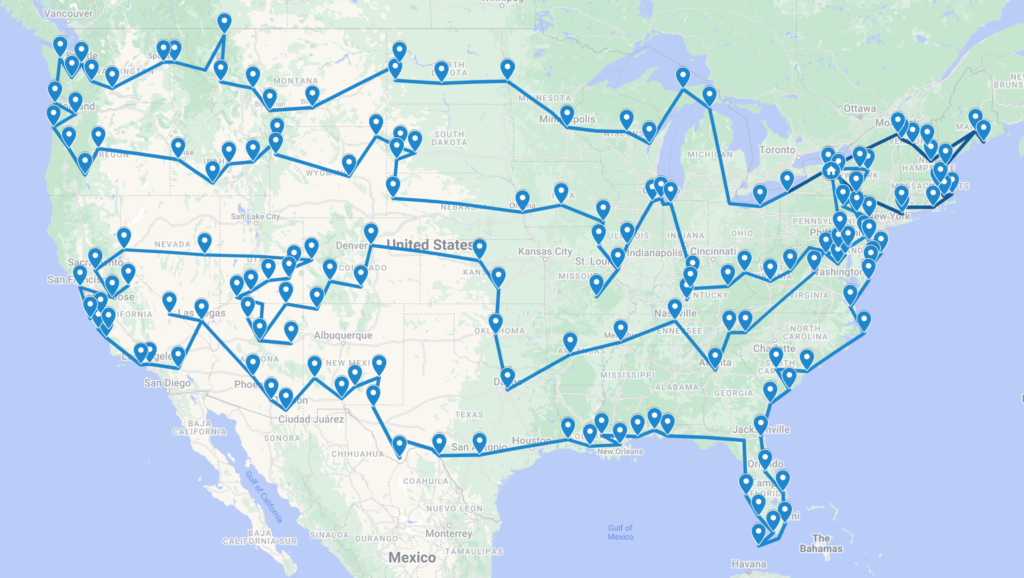By Shelby

Monday we worked a little from the hotel we stayed at the previous night, the Days Inn in Fargo. After checkout, we went to Leisure Laundry to do laundry and worked from there. Then we moved on to the Fargo Public Library to finish work for that day. After work, we drove two and a half hours west to Bismarck. We drove through a storm along the way and the temperature dropped from almost 100 degrees to 65. It was pretty crazy! The drive was more interesting than I had expected. It was very flat and had many farms, but there were also quite a few small lakes.

When we arrived in Bismarck, we went to the grocery store to pick up some food for dinner. Our next meal was going to be salad with grilled chicken. The weather was going to be hot again for the next few days, so a cold meal would be good.

Tuesday we worked from the North Dakota State Library. The building was part of the State Capitol and looked pretty fancy. After work, we drove to Sertoma Park to make dinner. Spencer cooked the chicken while I chopped up an onion and tomatoes. The salad was pretty good. After dinner, we went for a walk through the park. We caught a nice sunset over the small creek running alongside the park.

We worked from the Bismarck Veterans Memorial Library on Wednesday. After work, we went back to Sertoma Park to have dinner and relax. We also set up our hammock on a couple of trees. It seemed to work well. It’s a two-person hammock and we could both fit, but it’s more comfortable with just one person. We don’t plan on using it for sleeping like some people do.

Thursday morning we finished a little work from a hilltop park in Bismarck. The park overlooked the Missouri River. Spencer took my camera on a little trail while I stayed in the car. He took a path to Chief Looking Village and read about Native American history in the area. He must have accidentally changed the camera settings because every picture he took was black and white. We got a good laugh from that. We found that Bismarck, and North Dakota in general, were surprisingly nice.

Thursday afternoon we went to Raging Rivers Waterpark and spent the day there since the temperature was going to be 95. It was nice to have a relaxing day. I guess many other people had the same idea because the park was very crowded but the wait for the slides was never too long. When we left the water park at closing time, we got frozen yogurt and went grocery shopping.

We got up early Friday morning to start on our 2-hour drive to Theodore Roosevelt National Park. The drive was very flat and grassy. Along the way, my phone changed to an hour earlier. Apparently, we traveled into a new time zone and didn’t even realize it. We arrived at our first stop, the Painted Canyon Visitors Center. The landscape was completely different from the grassy plains we had been driving through.

From the visitors center, we did a short 1 mile hike down into the badlands. It was very pretty. We even saw a few rabbits who didn’t seem afraid of us at all. After we finished the trail, we made sure to get a picture with the Theodore Roosevelt National Park sign. We drove on to Medora, a small town right outside the park. The town seemed very western themed. Even the street signs looked like they were from an old western movie.

Our plan for the park was to drive along the 36 mile scenic loop road. Unfortunately, a small section of it was closed for repairs, so we would have to drive out and back instead. Throughout the park, we stopped at multiple overlooks and scenic areas. The first stop was the Medora Overlook. From here, we had a nice view of the small town.

One of my favorite stops was next – the Prairie Dog Town. At this stop, we saw many prairie dogs popping out of their holes. Their barks sounded more like squeaks. They were very cute. At one point we saw one squeal and then jump into a hole. It must have sensed danger nearby.

Our next stop was the Skyline Vista. This is where we saw our first bison. There was a nice overlook a short walk from the parking lot where we could see the badlands. There was a single bison grazing on grass on top of a hill. It was very cool to see. The other people at the stop were also very excited about seeing the bison.

Next up was the Wind Canyon, a short trail leading up to a view of the Little Missouri River. Along the trail, we saw many small pink and white flowers. They were very pretty. When we reached the viewpoint, along with the river, we also saw a huge herd of bison. They were pretty far away, so we used Spencer’s monocular to get a better view. Spencer was even able to get a picture of the bison through the monocular!

Our next stop we had completely to ourselves. This was the Boicourt Overlook and trail. A short walk from the parking lot led us right out on top of a butte in the badlands. The lower grassy area reminded us of a golf course, with all of the small hills. When we made it back to the parking lot, there were many cars there. There was a small herd of wild horses in the field across the street everyone was taking pictures of. There were even two babies!

Our next stop was Buck Hill, the second highest point in the south unit park. From the parking lot, we saw another group of wild horses grazing on grass. We climbed up to the top of the hill and had a great view of the badlands. However, the wind had picked up and we were nearly blown over. It was also getting cold, so we hurried back to the car after getting a few pictures.

The Old East Entrance was our next stop. This was the original entrance into the park. There was a short trail leading to an old building that was built in the 1930s. As we walked along the trail, we saw several prairie dogs. One of them walked pretty close to us. We weren’t able to make it to the building as a bison made its way across the path in front of us. We waited a while to see if it would move, but it started to walk toward us. We decided to turn back and move on to the next spot.

Our final stop was the North Dakota Badlands Overlook. We got another great view of the badlands from here. We learned that early explorers named this area “Badlands” because of how difficult it was to traverse. The land is filled with cliffs, cacti, rattlesnakes, and limited water sources. This was the last stop before the road closed, so we drove back to the visitors center from here.

Our plan for the night was to stay at a free primitive camping site about 10 minutes from the park. We weren’t sure if we would be able to make it because it was on a long gravel road, but luckily we did make it. It was an amazing spot. We had a great view of the badlands all around us and it was very quiet. We relaxed at the site for a while and ate dinner. We planned to return to the park before going to sleep to use the restroom at the visitors center and get more water.

Unfortunately, when we arrived at the visitors center later that night, the bathrooms were locked. We had to go further into the park to find a different bathroom. This did work out, though, because we caught a great sunset at the Skyline Vista. We also saw a couple more bison. After sunset, we returned to the campsite to sleep.

We woke up early the next morning to drive to the north section of the park. This is completely separate from the south section and was about an hour drive. The north section of the park is smaller than the south. The scenic road going through the north is only 14 miles long, much shorter than the south unit scenic road.

This day was much colder than the prior and it was very windy. We had to get our winter hats out and wear multiple layers. One of our first stops was at the cannonball concretions, strange sandstone balls. No one knows why they formed as spheres. They were pretty neat. In the same area, there were also a few small caves that we could step into.

Our next stop was the Caprock Coulee Trail. When we started the trail, we only intended to walk the first mile or so. We decided to continue on and finish off the whole 4-mile trail because it seemed pretty interesting. At the start of the trail, we walked through the foresty area in the valley between the buttes. It was very muddy. We almost slipped multiple times and we climbed up hills. Eventually, we came to a more open, grassy area. We remained constantly alert for any bison in the area. We saw their footprints everywhere. In the grassy area, there were a few canyons we had to step over. There was a single wood plank acting as a bridge over a larger canyon. It looked pretty deep! There were also many wildflowers in all colors. Past the grassy area, we continued climbing upward until we were on top of the buttes. From here we had a good view of the badlands around us. There was even a bench to rest on for a minute.

We continued on the trail until we came to the River Bend Overlook. This area overlooked the Little Missouri River. There was a stone structure built in 1937 by the CCC that provided shelter at the edge of the cliffside. After taking a bunch of pictures, we continued on the trail. This section was more interesting than the first half of the trail. The views along the trail were more scenic and the landscape was unique. We got to walk directly on the tops of the buttes and step over deep canyons.

After we made it back to the car, we moved on to the next few stops. One was at an overlook of the area we just hiked through. We learned that the weird dirt we walked on at the top of some of the buttes was bentonitic clay. As we continued through the park, we saw a large grassy area with a bunch of bison, so we stopped briefly to take a picture. Our final stop in the park was the Oxbow Overlook where we got another scenic view of the badlands and the Little Missouri River. After that, we drove back to the visitors center. We had a five-hour drive ahead of us to Billings, Montana. You can see more of our pictures from the park here.

We switched off driving a few times throughout the five-hour drive. The landscape started out very flat and grassy. We passed through many farmer’s fields. We stopped at a rest area in Montana where we saw a view of the Yellowstone River. There was also a sign warning that rattlesnakes have been seen in the area. As we approached Billings, we ended up racing a train that was moving parallel with us. In Billings, we ate dinner in a small park and then slept in a Walmart parking lot, amongst multiple other campers and campervans. Our plan for Sunday is to relax in Billings, work on the website and do laundry. This was another good week. We’re looking forward to exploring Montana next week!
Fun Facts from Week 9:
- Lewis and Clark traveled through modern-day Bismarck, North Dakota on their 1804 expedition across the U.S. They paddled up the Missouri River and traded with Native Americans in the area.
- Prairie dogs live in an extensive network of underground tunnels. There are watchdogs or sentries that stand guard at the opening of the tunnel. If they notice danger, they will bark and the prairie dogs will run back into their tunnels.
- Despite bison commonly being referred to as buffalo, there are no buffalo in North America, only bison. Actual buffalo exist in Asia and Africa. The misconception is in part due to early French explorers referring to the animals as “le bœuf”, meaning “beef”.
- The south unit of Theodore Roosevelt National Park is in the Mountain Time Zone, but the north unit is in the Central Time Zone.





2 responses to “Week 9”
Prairie dogs! Cool
OMG what an amazing time you are having!